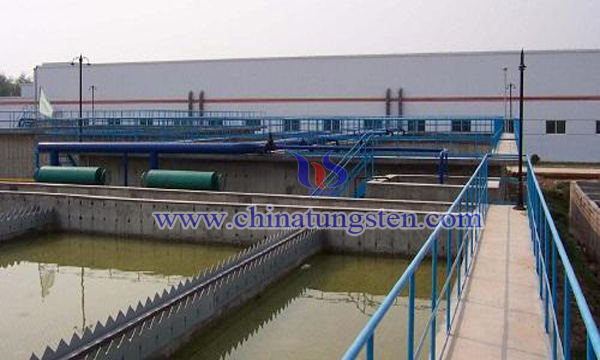Tungsten Wastewater Comprehensive Treatment Strategy
- Details
- Category: Tungsten Information
- Published on Sunday, 09 December 2018 19:14
At present, the self-developed ion exchange process is widely used in the production of ammonium paratungstate (APT) in China. Its advantages are stable product quality and easy operation. However, the major disadvantage of this process is that it uses a large amount of water and consumes more than 100 tons of water per ton of APT production. Therefore, the treatment of smelting wastewater is a very headache.

Some scholars put forward a method of removing contamination and recovering tungsten in the treatment of tungsten wastewater, which can remove organic flotation reagents and harmful elements arsenic and phosphorus from APT wastewater with large discharge. The contents of the method are as follows:
(1)After exchanging strong alkaline anion resin in sodium tungstate solution, hydrochloric acid was added to adjust the waste liquid to weak acidic pH=3-6, and a small amount of polyacrylamide was added to flocculate a large number of flotation reagents and silicic acid into fine solid particles in the solution. Then they were thoroughly removed by PE sintered tubular filter specially designed for environmental protection. Interference in the exchange process of anion resin;
(2)The weak acidic wastewater after suspension removal is injected into the exchange column with D-type anion resin, and all arsenic and phosphorus in the wastewater are adsorbed by D-type anion resin;
(3)The resin is desorbed by caustic sodium solution, and the desorption solution is concentrated, so that 90% of tungsten is precipitated by Na2WO4·2H2O crystallization, and the mother liquor enriched with As and P is returned to the leaching concentrate. Most of the harmful elements react with additives and enter the slag phase for removal.
Implementing the ion exchange method with different conditions can ensure the thoroughness of adsorption of tungsten and arsenic by resin, reduce the harmful element arsenic from 1.5mg/L to less than 0.05mg/L, and ensure that the arsenic content in the effluent is lower than the first-class standard as < 0.5mg/L of the Comprehensive Wastewater Discharge Standard, and that the harmful element arsenic in the effluent can be reduced to less than 0.05mg/L. In the first strong basic anion resin exchange process, the valuable metals were completely recovered from the leak through to the liquid after delivery. The zero discharge of tungsten was realized, and the metal recovery rate was increased from 93-94% to 96-97%.
- Tungsten Manufacturer & Supplier, Chinatungsten Online: www.chinatungsten.com
- Tungsten News & Prices of China Tungsten Industry Association: www.ctia.com.cn
- Molybdenum News & Price: news.molybdenum.com.cn
- Tel.: 86 592 5129696; Fax: 86 592 5129797; Email: sales@chinatungsten.com



 sales@chinatungsten.com
sales@chinatungsten.com